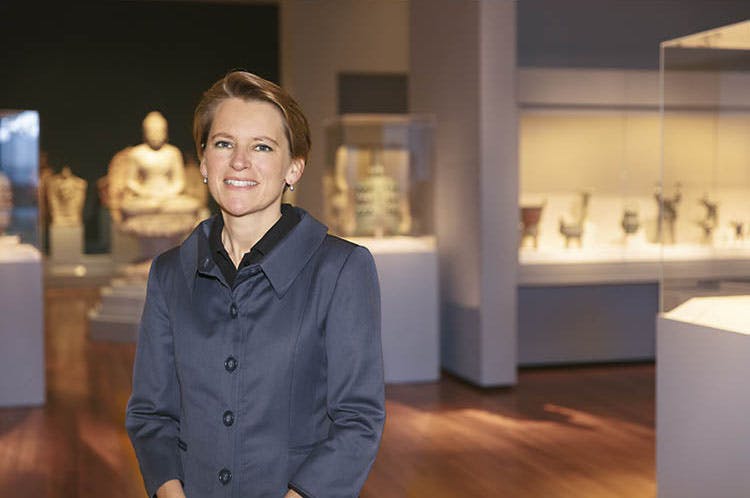
Interview: Clarissa von Spee
Tags for: Interview: Clarissa von Spee
- Magazine Article
- Staff
Better understanding the close cross-cultural ties among Asian cultures
December 16, 2016
Appears in Cleveland Art, January/February 2017

Interview December 2016
Clarissa von Spee, the museum’s curator of Chinese art and head of the department of Asian art, arrived here in October after eight years at the British Museum as curator of the Chinese and Central Asian collections. A prolific author, the German native studied at Heidelberg University and the Sorbonne, and has conducted extensive research in China. The magazine staff spoke with her recently about our Asian art collection that she now oversees.
You’ve published widely and organized exhibitions spanning Chinese art history, from ancient to contemporary. What are your thoughts about how the past and the present relate in Asian art?
Contemporary objects can often help us understand the past. For example, take the recent acquisition New Primordial Chaos by Michael Cherney. At first sight the work is in the traditional format of a handscroll; it looks like an ink painting depicting the full moon at night, but then you gradually discover that it’s a photograph. I think it’s fascinating that Michael, who lives in Beijing, says that this misty romantic atmosphere and blurred silhouette of the moon is in fact the effect of Beijing’s air pollution. You have these reflections back and forth, so I think contemporary art can help us trace and reference the past, while simultaneously serving as a statement about the present. Another aspect of this view is that young audiences respond well to contemporary works. Museums need to draw the attention of younger visitors, and a contemporary art object can sometimes provide an incentive for them to visit the permanent galleries.
What are your general thoughts on the museum and Cleveland’s collection?
The Chinese art collection is among the finest in the United States; it is outstanding in terms of the high quality of each object as well as the breadth of the material. And that’s true for the museum’s overall Asian collections—their quality and breadth. The Cleveland Museum of Art is an international player. We are represented in touring exhibitions and frequently lend works to peer institutions. The curators are highly accomplished scholars, each an expert in his or her own field. These factors combine to create a stimulating work environment.
Do you think of your work as being directed toward an international audience?
Yes, but I am coming from the British Museum in London, which has a large and diverse audience, mostly tourists. In contrast, here I have already learned and can see what a central place the Cleveland Museum of Art holds in this community. It’s really on the mind of the people, and they are proud of it. This makes working at the museum a unique opportunity.
Through news about acquisitions, exhibitions, and educational programs, I am confident that we can maintain Asia’s visibility in the museum and out in the community, which I know can be promoted through the energetic work of our strong, active curatorial team.
Working with Sonya Quintanilla, Sinéad Vilbar, and Sooa McCormick, how do you see yourselves collaborating in the galleries and maintaining that visibility for visitors?
My vision is to present not only the differences among Asian cultures but also their common aspects. One simple example is Buddhism. In our galleries we have Buddhist objects in various manifestations from India, China, Japan, Korea, and Southeast Asia, so while Asia can be perceived as an entity it can also be seen in all its diversity. Many museums own Buddhist paintings that cannot be clearly identified or attributed to either Japan, Korea, or China, and they often keep such paintings in storage. I want us to show these works and address these questions to better understand the close cross-cultural ties and interactions among Asian cultures.
Are there particular areas in the galleries or the collection that you would like to enhance?
I think the display in the Chinese art galleries is thoughtful and visually attractive, reflecting the strengths of the collection quite well. We have many fine lacquer pieces, but only a few of them are out. Of course lacquer is light sensitive, so it can’t be on view all the time, but we can make sure in our displays that visitors see not only rotations of paintings but also other light-sensitive works like textiles, lacquer, prints, and calligraphy. These are areas where we could improve the visitor experience either by increasing the visibility of what we already have or by acquiring new works.
Do you have favorite pieces in this collection?
Not really. I believe that once you engage with an object it becomes your favorite. Each time I go through the galleries, I discover something new, and then the next time I discover something else. I hope that’s the same for our visitors. When you spend time with an object and get to know it, even something very unobtrusive becomes fascinating.
Image

New Primordial Chaos 2014. Michael Cherney (American, born 1969). Photograph in handscroll format, ink on mitsumata washi paper; image: 29.7 x 86.2 cm; scroll: 31.6 x 337.2 cm. The Jane B. Tripp Charitable Lead Annuity Trust, 2015.80